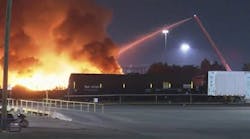Several years ago, I walked into a deputy fire chief's office and saw a sign hanging behind his desk. The sign read "problEMS." In essence, the last three letters of the word "problems" was capitalized and it read EMS. He thought it was cute and funny at the same time. But it confirmed what I thought was his mindset when it came to fire service EMS and firefighter/paramedics. Ironically, I was there to talk him about a problem related to a suppression issue.
The deputy fire chief turned his chair and pointed to the sign, "Did you see my new sign?" I answered, "Yeah, I saw it. What does it mean?" His reply did not make any sense as he stumbled through an explanation that included some situation concerning a firefighter/paramedic the previous year. Obviously, he was reaching and tried to come up with some type of logic, but he sounded like a kindergartner trying to explain calculus.
Unfortunately, his attitude was microcosm of the more global picture. That more global picture is that some in the fire service begrudgingly accept EMS as a part of one of its main delivery functions, except when it's time to ask for more money in the budget because of all the EMS run numbers. There are still some in the fire service who believe that unless smoke and fire are showing, the word "fire department" is not attached to it.
It is not, however, an "us-versus-them" situation. I fit both disciplines; I like firefighting and I like EMS. You do not have to find yourself in one camp either. Whether you are a firefighter doing suppression, EMS, prevention, hazardous material mitigation, inspections or public education, you are still a member of a fire department.
Now, the alarm bells are ringing and not for fires, which, I might add, are not as plentiful as they use to be. That alarm comes in the form of a report titled, "Back to the Future: An Agenda for Federal Leadership of Emergency Medical Services," released by the George Washington University Homeland Security Policy Institute. The report proposes moving EMS leadership from where it currently resides, with the Department of Transportation's National Highway Traffic and Safety Administration, to the Department of Homeland Security, where it would be of equal status with the U.S. Fire Administration (USFA) under the Federal Emergency Management Agency (FEMA). The report calls for the formation of a U.S. Emergency Medical Service Administration. This report has become a rallying cry for those who are non-fire service EMS providers and want federal dollars.
Bottom line, unless the fire service wakes up and truly embraces EMS, it stands the possibility that a federal agency that does not have fire service interest as a first priority will be dictating future policy that impacts training, collection of data, finances, grants, and a host of other items.
EMS delivery is a system. It is just not an ambulance showing up at a scene and transporting someone to a hospital. It starts in the communications center, where trained dispatchers evaluate calls and provide pre-arrival instructions. An EMS system also includes first responders, usually firefighters, responding to a scene and providing basic or advanced life support. Finally, an EMS system includes a transport vehicle showing up on a scene and transporting someone to a hospital.
The George Washington University report is obviously slanted and does not provide a clear picture of emergency medical service delivery in the United States. In fact, some who were listed on the George Washington University report from the fire service have withdrawn their names.
If you look at the latest Journal of Emergency Medical Services survey of the 200 most populous U.S. cities, the fire service delivers over 90% of emergency medical response, and these are not the smallest cities, these are the most populous cities.
Responding to the report, the International Association of Fire Chiefs, International Association of Fire Fighters, International Association of Arson Investigators, International Fire Service Training Association, National Fire Protection Association, National Volunteer Fire Council and North American Fire Training Directors sent a joint letter to Homeland Security Secretary Michael Chertoff, indicating their disagreement with the report. The letter states, "we fervently believe that changes proposed in his report would have a deleterious effect on EMS and undermine all progress made to date within DHS to coordinate and consolidate homeland security policies and programs consistent with the mission of your department."
Other national EMS organizations such as The National Association of State EMS Directors, The National Association of EMS Physicians, and The National Association of EMS Educators have all also issued a policy statement disagreeing with the George Washington University report.
The establishment of a federal EMS agency to handle everything would create a nightmare of bureaucracy just to get up and running. In the meantime, all the programs under way for EMS would come to a standstill. And after an EMS administration is up and running, expect federal homeland security money to be allocated to support for-profit EMS agencies that would claim they are also a part of the EMS equation and should not be left out.
The National Highway Traffic Safety Administration's EMS Division is to be complimented on where it has brought EMS in the last 30 years. One look at its accomplishments and the programs it has underway with a small staff would leave one to marvel.
Now is the time to move forward. Senator Susan M. Collins (R-Maine) has introduced a bill proposing that the coordination of EMS be done through a Federal Interagency Committee on EMS (FICEMS). Beside the DOT, EMS is represented in the Department of Health and Human Services, the Department of Homeland Security, and the Centers for Disease Control and Prevention. Most of the items proposed through an EMS administration would be obtainable through FICEMS. A national training academy, coordination of data and coordination of federal grants are obtainable without reinventing the wheel.
So as the alarm bells continue to ring, the fire service needs to wake up. The USFA needs to include in its mission statement that EMS is a vital part of the fire service. Fire departments that spend 80% of their budgets on suppression, although it is 20% of their workload, and 20% of their budgets on EMS, when it is 80% of the workload, need to refocus and reprioritize.
Will there still be dinosaurs who refuse to move in this direction? Yes! But the fire service experienced the same debate when fire departments started moving fire horses out of the firehouses and started replacing them with motorized apparatus. Eventually, the dinosaurs who screamed about replacing their horses faded away. And eventually, those who hang signs with the word "problEMS" in their offices will also fade away. Hopefully, they will fade away before the fire service sees what it has being taken away by those who do not have the fire service at heart.
Gary Ludwig, MS, EMT-P, a Firehouse contributing editor, is deputy chief of EMS in the Memphis, TN, Fire Department. He has 28 years of fire-rescue service experience, and previously served 25 years with the City of St. Louis, retiring as the chief paramedic from the St. Louis Fire Department. Ludwig is vice chairman of the EMS Section of the International Association of Fire Chiefs (IAFC), has a master's degree in business and management, and is a licensed paramedic. He is a frequent speaker at EMS and fire conferences nationally and internationally. He can be reached through his website at www.garyludwig.com.





